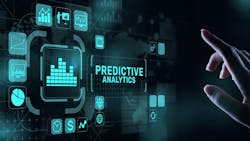6 Ways Procurement Can Leverage the Power of Predictive Analytics
Download this article in PDF format.
Predictive analytics came on the business scene several years ago, bringing with it the chance to get a glimpse of what might be “coming next” and act accordingly. The examination of data in order to answer questions, identify trends and extract insights, predictive analytics uses historical information to forecast potential scenarios. With this information in hand, companies can make more strategic, informed decisions.
Giving procurement departments the power to “see ahead” based on historical trends has become a hot market for predictive analytics platform developers. In fact, the market for procurement analytics platforms is currently experiencing a compound annual growth rate (CAGR) of about 22%, according to a new Stats N Data report.
6 Good Uses for Predictive Procurement Analytics
Procurement analytics involves the application of advanced analytics techniques to procurement data, enabling organizations to optimize sourcing strategies, mitigate supply chain risks and drive cost savings. “By leveraging data-driven insights,” Stats N Data reports, “organizations can enhance supplier performance, negotiate favorable contracts, and ensure compliance with regulatory requirements.”
Here are six more ways procurement departments can leverage the power of predictive analytics:
- Improved risk management. Procurement analysis can help predict supply chain changes, pinpoint single-source items and monitor the financial stability of key suppliers. “In addition, data-based decision-making helps eliminate the risks introduced by human bias,” Responsive, Inc., says in A beginner’s guide to procurement analytics.
- Better decision making. By analyzing past trends and data, companies can anticipate demand, adjust inventory levels and refine supplier selection and negotiation tactics. “This foresight into market shifts and changes in demand enable companies to make sourcing decisions that deliver cost benefits and increase operational efficiency,” according to McKinsey & Co.
- Lower procurement costs. Effective analysis can reduce maverick spend, optimize category management and support supplier base rationalization. For example, analyzing historical pricing data can lead to improved supplier negotiations and contract terms, while also enabling the identification of alternative sourcing opportunities. “It also helps to anticipate and mitigate risks such as supply chain disruptions or price volatility, minimizing the cost impact,” McKinsey adds.
- Support broader company initiatives. As organizations seek to align their procurement strategy more closely with big-picture goals, procurement analytics offers a way to track progress, monitor results and predict outcomes. “For instance, gathering and analyzing vendor diversity data can ensure ROI and help the organization further optimize their diversity spend goals using data,” Responsive points out.
- Improve demand forecasts. Predictive analytics can also be used to forecast demand by analyzing past purchasing patterns, supplier information and market conditions. It can also be used to optimize global supply chains, namely by proactively identifying potential bottlenecks and inefficiencies. “It can also help organizations optimize their processes for greater efficiency and cost savings,” GEP explains in Know What’s Coming: Leveraging Predictive Analytics in Procurement.
- Identify new suppliers. “Predictive analytics can be used to identify potential new suppliers by analyzing the company’s current supplier base and market conditions,” GEP says. “This can help organizations find new suppliers that can provide better services and more competitive prices.” And once those new suppliers are onboard, predictive analytics can be used to “identify potential risks and opportunities associated with their suppliers and make better informed decisions.”
About the Author
Avery Larkin
Contributing Editor
Avery Larkin is a freelance writer that covers trends in logistics, transportation and supply chain strategy. With a keen eye on emerging technologies and operational efficiencies, Larkin delivers practical insights for supply chain professionals navigating today’s evolving landscape.






